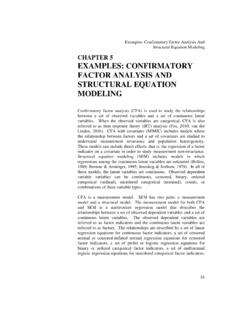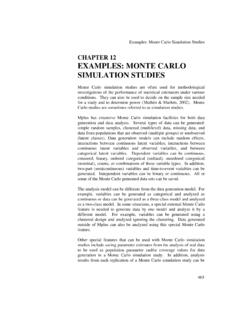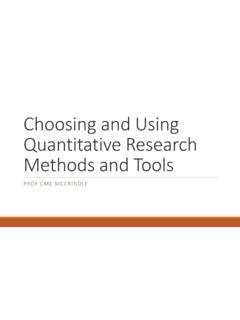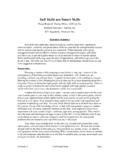Transcription of Identity Statuses as Developmental Trajectories: A …
1 EMPIRICAL RESEARCHI dentity Statuses as Developmental trajectories : A Five-WaveLongitudinal Study in Early-to-Middle and Middle-to-LateAdolescentsWim Meeus Rens van de Schoot Loes Keijsers Susan BranjeReceived: 23 June 2011 / Accepted: 3 November 2011 The Author(s) 2011. This article is published with open access at study tested whether Marcia s originalidentity Statuses of achievement, moratorium, early closure(a new label for foreclosure), and diffusion, can be con-sidered Identity status trajectories . That is, we examinedwhether these Statuses are distinct and relatively stable,over-time configurations of commitment strength, levels ofin-depth exploration of present commitments, and consid-eration of alternative commitments. The study examinedidentity development in a five-wave study of 923 early-to-middle ( female) and 390 middle-to-late adolescents( female), covering the ages of 12 20.
2 Using Latentclass growth analysis (LCGA), the authors found thatMarcia s (1966) Statuses are indeed Identity status trajec-tories. Two kinds of moratorium were also found: theclassical moratorium and searching moratorium. Supportwas found for Waterman s Developmental hypothesis of theidentity status model: the number of achievers was sig-nificantly higher, and the number of diffusions lower, inmiddle-to-late adolescence than in early-to-middle ado-lescence. Females were more often in the advanced identitystatus trajectories , and stable differences were foundbetween the trajectories in psychosocial adjustment. Studyfindings highlight that Identity formation should be con-ceptualized as an over-time Identity status trajectories Adolescence Psychosocial adjustment Latent classgrowth analysis (LCGA)IntroductionErikson (1968) postulated that one of the main tasks foradolescents is to develop a coherent sense of Identity .
3 InErikson s life course theory, a coherent Identity is assumedto be important for being a caring intimate partner and acompetent parent. Marcia s Identity status model has beenone of the most important elaborations of Erikson s viewson Identity formation. Marcia (1966) distinguished fouridentity Statuses , based on the amount of exploration andcommitment the adolescent experiences (or has experi-enced). Identity diffusion (D) indicates that the adolescenthas not yet made commitments regarding a specificdevelopmental task, and may or may not have exploreddifferent Developmental alternatives in that domain. Fore-closure (F) means that the adolescent has made a com-mitment without exploration. In moratorium (M), theadolescent is in a state of active exploration and has madeno commitment, or at best an unclear one.
4 Identityachievement (A) signifies that the adolescent has finisheda period of active exploration and has made a relatedcommitment. Numerous studies have found support forMarcia s Identity status classification (Meeus2011).Originally, Marcia repeatedly had stated that the identityconflict is resolved between the ages of 18 and 22, and thatthe Statuses were intended to measure Identity in lateadolescence (Marcia1980). The Identity status interview(ISI) is the standard instrument to tap the Identity ISI is a partly retrospective interview that captures thepast process of Identity formation, as well as presentW. Meeus (&) L. Keijsers S. BranjeResearch Centre Adolescent Development, Utrecht University,PO Box , 3508 TC Utrecht, The Netherlandse-mail: van de SchootDepartment of Methods and Statistics, Utrecht University,Utrecht, The Netherlands123J Youth AdolescenceDOI commitments.
5 As such, the Identity Statuses indi-cate both the Developmental process of Identity formationand its outcome. This process orientation, in particular, hasled researchers to extend the study of Identity formationfrom late to early and middle adolescence. Marcia (1993a)also increasingly has accepted the idea that the identitystatus model could be used to describe the actual process ofidentity development in early and middle , the main research question of the present studyis whether Identity Statuses are indeed Identity status tra-jectories in early-to-middle and middle-to-late other research questions are whether prevalence ofachievement is higher, and of diffusion is lower, in middle-to-late adolescence than in early-to-middle adolescence;whether there are gender differences in prevalence ofidentity status trajectories ; and whether the Identity statustrajectories show stable, over-time differences in adjust-ment.
6 We will start with introducing the Identity modelused in this Dimensional Approach: Commitment, In-DepthExploration, and ReconsiderationThe present study uses the three-dimensional Meeus-Crocetti model (Crocetti et ; Meeus et )toconstruct Identity status trajectories . This model focuses onthe management of commitments and posits three dimen-sions as underlying the process of Identity to strong choices that adolescents havemade with regard to various Developmental domains, alongwith the self-confidence that they derive from these explorationrepresents the ways in whichadolescents maintain their present commitments. It refersto the extent to which adolescents actively explore thecommitments that they already have made by reflecting ontheir choices, searching for information about these com-mitments, and talking with others about of commitmentrefers to the willingness to discardone s commitments and to search for new refers to the comparison of present com-mitments with possible alternative commitments when thepresent ones are no longer satisfactory.
7 The Meeus-Crocettimodel assumes that Identity is formed in a process of con-tinuous interplay between commitment, in-depth explora-tion, and Meeus-Crocetti model also holds that individualsenter adolescence with a set of commitments of at leastminimal strength in important ideological and interpersonalidentity domains, and that adolescents do not begin theidentity development process with a blank slate. Theinitial commitments build upon the ways in which ado-lescents have resolved the earlier Eriksonian psychosocialcrises during childhood, and have developed the egostrengths of hope, will, purpose and competence (Erikson1968). Numerous studies have offered support for theseassumptions. Markstrom et al. (1997) and Markstrom andMarshall (2007) found clear links between previous Erik-sonian ego strengths and Identity achievement.
8 Moreover, anumber of studies have suggested that early adolescentscan possess strong Identity commitments (Adams andJones1983; Archer1982; Meeus et ).During adolescence, individuals manage their commit-ments in two ways, namely through in-depth explorationand through reconsideration. In-depth exploration is aprocess whereby individuals continuously monitor presentcommitments, which serves the functions of making themmore conscious and maintaining them. Reconsideration isthe process of comparing present commitments withalternative ones, and deciding whether they need to bechanged. The Meeus-Crocetti model, therefore, focuses onthe dynamic between certainty (exploration in depth) anduncertainty (reconsideration).Importantly, the Meeus-Crocetti model differs fromMarcia s model in two respects.
9 First, it splits Marcia sconcept of exploration into in-depth exploration andreconsideration, which serve to maintain and changecommitments, respectively. Secondly, the Meeus-Crocettimodel has a stronger process orientation than Marcia smodel. Marcia views commitments as the outcome of theprocess of exploration; after exploring various alternativecommitments, adolescents choose one or more to whichthey will adhere. In contrast, the Meeus-Crocetti modelassumes, as suggested by Grotevant (1987, p. 214), thatcommitments are formed and revised in an iterative processof choosing commitments and reconsidering them. Inaddition, the model assumes that adolescents regularlyreflect upon their present commitments. In sum, its con-ceptualization of the process of Identity formation implies atwofold management of present commitments.
10 This con-ceptualization of in-depth exploration and reconsiderationresembles the distinction between exploration in depth andexploration in breadth that was originally suggested byGrotevant (1987), and that has been applied by Luyckxet al. (2005) in their dual-cycle model of including commitment, exploration in depth, andreconsideration in the model, Meeus and Crocetti sought tocapture Erikson s (1968) dynamic ofidentity versus iden-tity diffusion. Commitment and in-depth exploration, on theone hand, and reconsideration, on the other hand, areconceptualized as the two opposing forces within thisdynamic. Whereas commitment and in-depth explorationimply attempts to develop and maintain a sense of self ( , Identity coherence or synthesis), reconsideration representsquestioning and rethinking this sense of self (identityconfusion).

















